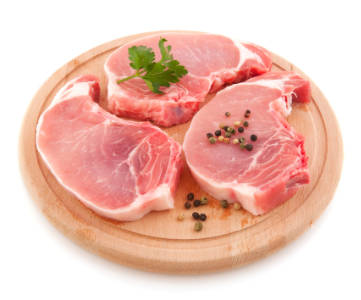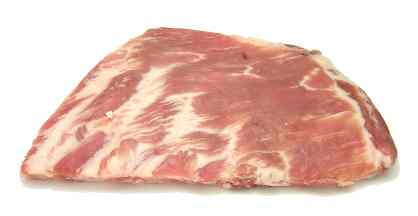Meats Category

pork back ribs
These ribs are meatier than spareribs, but they're not as meaty as country-style ribs. Allow 2/3 pound per person.
Learn morepork blade roast
This somewhat fatty, economical roast is sold either bone-in and boneless. If you buy it as a bone-in roast, make sure that the butcher has cracked the backbone between the ribs so it's easy to carve. Country-style ribs are cut from this piece.
Learn morepork blade steak
These are cut from the Boston butt, and they're a cheap and flavorful alternative to pork chops. They're a bit too tough to fry, but they're wonderful if slowly braised.
Learn morepork butterfly chop
This is a thick chop taken from the loin eye which is cut almost in half so that it forms a butterfly pattern when opened on the hinge.
Learn morepork center loin roast
For many cooks, this lean and tender cut makes the best pork roast of all. One drawback is that it includes part of the animal's backbone, which adds flavor but can make the roast hard to slice after cooking. One solution is to ask your butcher either to cut off the bone and tie it back on or to cut through the backbone in several places so that you can easily slice the cooked roast into chops. If the backbone is removed and the ribs are "Frenched" or trimmed of meat, this cut is called a rack of pork. To make a crown roast of pork, get two racks and tie them into a circular crown. Your roast will be moister if the butcher doesn't trim the big slab of fat that usually comes with this cut. The roast will be moister if you cut the fat off after the roast is cooked. Steaks cut from this roast are called pork loin chops or pork rib chops.
Learn morepork chop
Pork chops usually turn out juicier if they're thick and if they're attached to bone. Several different cuts are called pork chops. The most tender and expensive ones are the pork loin chop and the pork rib chop. Next in the tenderness hierarchy are the pork sirloin chop, pork top loin chop, and the pork loin blade chop. Pork arm steaks and pork blade steaks are relatively tough and fatty, but they're very flavorful. They're better if they're braised rather than grilled, broiled, or fried.
Learn morepork country-style ribs
These have more meat than spareribs or back ribs, but they aren't as easy to eat with fingers. Allow 1/2 pound per person. They come boneless (pictured) or bone-in.
Learn morepork cube steak
This is a relatively tough cut of meat, often from the shoulder, that the butcher tenderizes mechanically.
Learn morepork cubes
These are cubes that are put on skewers for grilling. Don't confuse cubes for kabobs with pork stew meat, which is too tough to grill.
Learn morepork heart
Pork hearts are a bit smaller than veal hearts. They're best cooked using moist heat, say by braising them or cooking them in a stew.
Learn morepork kidneys
Like beef kidneys, these are too tough to cook using dry heat. It's best to cook them slowly using moist heat. To prepare them, first cut off the outer membrane, then cut them lengthwise to expose a white blob of fat in the middle, which should be discarded. Next, soak the kidney in acidulated water or buttermilk for about an hour. This will make the flavor much more mild.
Learn morepork loin blade chop
These are cut from the blade roast, which is the part of the loin that's closest to the shoulder. You can grill, broil, braise, or panfry them. Don't confuse this cut with the pork blade steak, which is cut from the Boston butt and is fattier.
Learn morepork loin chop
This is distinguished by a T-shaped bone that's off to one side. It's a great chop to grill, broil, or panfry.
Learn morepork roast
You can oven-roast several pork cuts. Many cooks think that the pork center loin roast is the best choice--it's moist, tender, and flavorful. Pork tenderloins are also popular because they're lean, tender, and boneless. As you move away from the center of the pig, the roasts become either bonier or fattier or less tender, but they're more economical and often packed with flavor. Good choices include the pork top loin roast, fresh pork leg, pork sirloin roast and Boston butt.
Learn morepork sirloin cutlet
These lean steaks are similar to sirloin chops, only meatier and boneless.
Learn morepork sirloin roast
This is a fairly lean and economical roast. A bone-in sirloin roast contains parts of the hipbone and backbone, so it's tough to carve. It's usually worth the extra money to get a rolled and tied boneless sirloin roast.
Learn morepork spareribs
These aren't as meaty as country-style ribs or back ribs, but they're popular at barbecues since they're easy to eat with your fingers. Allow 4/5 pound per person. St. Louis style ribs are spareribs that have been trimmed of the brisket bone.
Learn morepork stew meat
This are pieces of meat that are too tough to grill, broil, or panfry. They're best if cooked very slowly in a liquid.
Learn morepork tenderloin
This cut is lean, tender, and boneless, so it commands a high price. It's delicious roasted, grilled, or broiled as long as you don't overcook it. Tenderloins are usually sold in pairs, and sometimes cut up into tenderloin pieces. If there's a silver membrane on the tenderloin, remove it before cooking.
Learn morepork top loin roast
To make a boneless roast, the butcher puts two top loins together and ties them up, fat sides out.
Learn morepoussin
A poussin is a very young chicken, and it has a very delicate flavor and very little fat. They're available in some gourmet markets.
Learn moreprosciutto
Prosciutto hails from Italy and is reknown for its delicate, salty flavor. It's usually cut into paper thin slices and served raw. Especially well regarded is Parma ham, which comes from Parma in Italy. Select a prosciutto that's shiny and deeply colored.
Learn morequail
Quails have dark meat that's quite tasty. They're very lean, so bard them before roasting or marinate them before grilling. Allow two quail per person.
Learn morerack of lamb
This elegant roast includes eight ribs, and it's big enough to serve three. If the meat at the tips is cut away to expose the bones, it's called a French rack = Frenched rack. Make sure the butcher cracks the chine (backbone) between the ribs, so that the roast is easy to carve when you take it out of the oven. You can make a double French rack by leaning two French racks against each other, bone tips interlaced. You can also tie two or three French racks together, bone tips up, to form a crown roast of lamb for an elegant meal
Learn morerattlesnake
A novelty item in the Southwest, rattlesnake meat resemble chicken, only it's chewier and has lots of small bones. Don't overcook it.
Learn morerhea
Rheas are the South American version of ostriches. Rhea meat resembles ostrich meat, but it's even leaner.
Learn moreringwurst
This pork and beef sausage looks and tastes like bologna. Germans like to heat it up and serve it with potato salad or bread.
Learn morerolled veal roast
This is an entire boneless shoulder that has been rolled and tied. It can be braised or roasted.
Learn moresalami
This is a family of ready-to-eat sausages that are made with beef and/or pork and heavily seasoned with garlic and spices. They're often used in sandwiches or antipasto plates. Many salami, like the popular Genoa salami, are air-dried and somewhat hard. Others, like cotto salami, are cooked, which makes them softer and more perishable. Most salami are made of pork, but all-beef kosher salami are also available. In Italian, salame is the singular form and salami the plural, but Americans often talk of one salami and many salamis.
Learn moresalpicão
This is a Portuguese pork sausage that's often served with rice and beans in Brazil.
Learn moresalt pork
This is a salt-cured chunk of fat that comes from pork bellies. It's used in much the same way as bacon, though salt pork is fattier and not smoked.
Learn moreSausages
A typical sausage consists of ground meat that's combined with fat, flavorings, and preservatives, and then stuffed into a casing and twisted at intervals to make links. Pork is most commonly used, but butchers also use beef, lamb, veal, turkey, chicken, or game, and some also use fillers like oatmeal and rice to stretch the meat a bit. Casings vary too--in addition to intestines or artificial casings, butchers sometimes use stomachs, feet, skins, or they do away with casings altogether and sell the sausage in bulk. After assembling a sausage, a butcher can either sell it as fresh sausage, or else cure, dry, or precook it in some way.
Learn more































































































































































































































































































































































